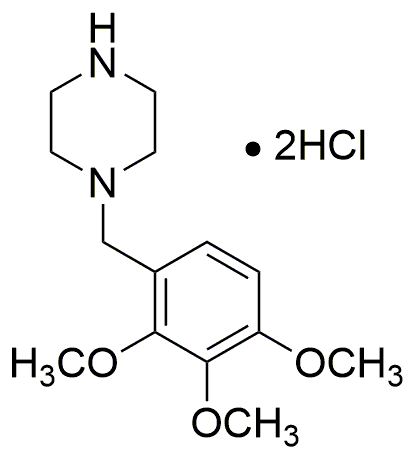Trimetazidine dihydrochloride is widely utilized in research focused on
- Cardiovascular Health: This compound is primarily used in the treatment of angina pectoris and other heart-related conditions, helping to improve blood flow and reduce chest pain.
- Neuroprotective Applications: Research indicates its potential in protecting neurons from damage, making it a candidate for studies related to neurodegenerative diseases.
- Metabolic Disorders: It has been explored for its role in enhancing glucose metabolism, which can be beneficial for patients with diabetes or metabolic syndrome.
- Sports Medicine: Athletes may use it to improve endurance and performance by optimizing energy metabolism, although this application is subject to regulatory scrutiny.
- Pharmaceutical Formulations: The compound is often included in various formulations due to its stability and efficacy, making it a valuable ingredient in cardiovascular drugs.
General Information
Properties
Safety and Regulations
Applications
Trimetazidine dihydrochloride is widely utilized in research focused on
- Cardiovascular Health: This compound is primarily used in the treatment of angina pectoris and other heart-related conditions, helping to improve blood flow and reduce chest pain.
- Neuroprotective Applications: Research indicates its potential in protecting neurons from damage, making it a candidate for studies related to neurodegenerative diseases.
- Metabolic Disorders: It has been explored for its role in enhancing glucose metabolism, which can be beneficial for patients with diabetes or metabolic syndrome.
- Sports Medicine: Athletes may use it to improve endurance and performance by optimizing energy metabolism, although this application is subject to regulatory scrutiny.
- Pharmaceutical Formulations: The compound is often included in various formulations due to its stability and efficacy, making it a valuable ingredient in cardiovascular drugs.
Documents
Safety Data Sheets (SDS)
The SDS provides comprehensive safety information on handling, storage, and disposal of the product.
Product Specification (PS)
The PS provides a comprehensive breakdown of the product’s properties, including chemical composition, physical state, purity, and storage requirements. It also details acceptable quality ranges and the product's intended applications.
Certificates of Analysis (COA)
Search for Certificates of Analysis (COA) by entering the products Lot Number. Lot and Batch Numbers can be found on a product’s label following the words ‘Lot’ or ‘Batch’.
*Catalog Number
*Lot Number
Certificates Of Origin (COO)
This COO confirms the country where the product was manufactured, and also details the materials and components used in it and whether it is derived from natural, synthetic, or other specific sources. This certificate may be required for customs, trade, and regulatory compliance.
*Catalog Number
*Lot Number
Safety Data Sheets (SDS)
The SDS provides comprehensive safety information on handling, storage, and disposal of the product.
DownloadProduct Specification (PS)
The PS provides a comprehensive breakdown of the product’s properties, including chemical composition, physical state, purity, and storage requirements. It also details acceptable quality ranges and the product's intended applications.
DownloadCertificates of Analysis (COA)
Search for Certificates of Analysis (COA) by entering the products Lot Number. Lot and Batch Numbers can be found on a product’s label following the words ‘Lot’ or ‘Batch’.
*Catalog Number
*Lot Number
Certificates Of Origin (COO)
This COO confirms the country where the product was manufactured, and also details the materials and components used in it and whether it is derived from natural, synthetic, or other specific sources. This certificate may be required for customs, trade, and regulatory compliance.


